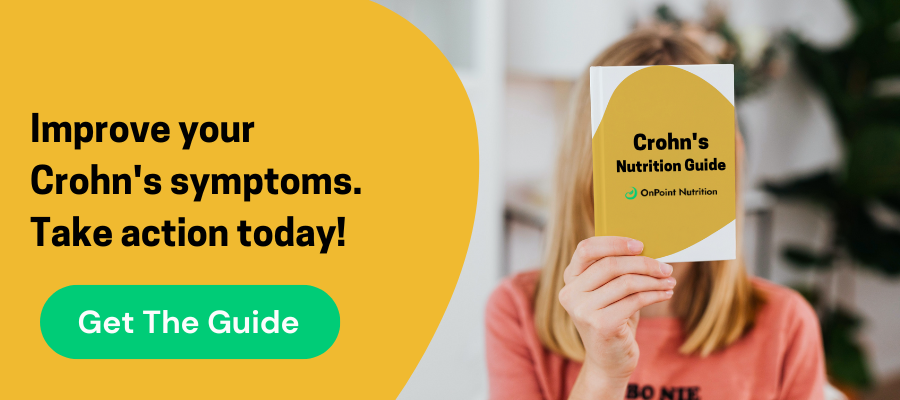
Crohn’s Disease is an Inflammatory Bowel Disease (IBD) that causes inflammation throughout the digestive tract. There are two stages of Crohn’s: active flare and remission. During an active flare, inflammation is worse and symptoms are active. During remission, there are no symptoms present. The goal of Crohn’s treatment and management is to achieve and maintain remission. Diet therapy plays a major role in Crohn’s management.
If you have Crohn’s Disease, you’ve probably spent some time searching the internet to figure out how to manage your condition. The good news is that the internet has a ton of information. The bad news is that the information you read about Crohn’s management can often be contradicting and confusing. So how are you supposed to find relief from your Crohn’s symptoms? Thankfully, we’ve done the hard work for you. We put together a how-to guide to help you best manage your condition.
What is a Crohn's Flare?
The most common symptoms of a Crohn’s flare are:
Frequent or urgent bowel movements
Significant changes in the frequency of bowel movements or unusual stool appearance can indicate a problem, especially when these changes accompany other symptoms such as diarrhea, constipation, or abdominal pain.
Diarrhea
Diarrhea is characterized by abnormally loose or watery stools. Most cases of diarrhea are due to bacteria, viruses, or parasites. Digestive system disorders can also cause chronic diarrhea.
Blood in Stool
Black, tarry stool may point to a bleed in your upper GI tract. As a general rule, the darker the blood, the higher the source of the bleed. Bright red blood is usually a sign of a bleed in the lower GI tract. This section consists of the large intestine, rectum, and anus.
Abdominal Pain
Crohn’s causes inflammation of the digestive tract lining, which results in pain, gas, diarrhea, nausea, vomiting, and bloating.
Weight loss
Crohn’s disease can cause inflammation in any part of the gastrointestinal tract, from the mouth to the anus. IBD can reduce the body’s ability to digest food properly or absorb nutrients, which can lead to malnutrition and weight loss.
Crohn's Disease flare symptoms can also include:
- Nausea and vomiting
- Fatigue and exhaustion with physical or mental activity.
- Lack of appetite
- Joint aches
- Body aches
- Rashes: rashes can vary in appearance greatly, and there are many potential causes. Because of the variety, there is also a wide range of treatments.
- Eye problems (pain, redness, loss of vision)
The Stages of Crohn’s Disease
Unfortunately, Crohn’s Disease is lifelong, but can be managed effectively through consistent food choices. The tough part is, there are different dietary recommendations for each stage of the condition: active and remission.
During an active flare, inflammation is worse and symptoms are active. During remission, there are no symptoms present. The goal of Crohn’s treatment and management is to achieve and maintain remission. Diet therapy plays a major role in Crohn’s management.
How to Treat an Active Crohn's Flare
A flare is the reappearance or worsening of disease symptoms. With inflammatory bowel diseases (IBD) such as Crohn’s Disease or Ulcerative Colitis (UC), specific symptoms will depend on which condition you have and the part of your gastrointestinal (GI) tract that is inflamed. For Crohn’s Disease, the active inflammatory response can lead to a symptom flare. Over time, symptoms can change or get worse (a term called a progressive disease).
What factors impact a Crohn’s flare?
- Missing, skipping or wrong medication dose
- NSAIDs can lead to bowel inflammation
- Antibiotics alter the bacteria in the intestine. These medicines can cause diarrhea and inflammation
- Stress
- Foods that irritate GI tract
When Crohn’s is active, let the bowel rest and heal as much as possible. Therefore, we recommend a low fiber, low residue diet.
Foods to Eat
- Low fiber fruit: bananas, cooked fruit, canned fruit
- Non-cruciferous vegetables: asparagus, potatoes, cucumbers, carrots
- Refined grain products: white pasta, white rice, white bread
- Lean protein: fish, chicken, lean pork, eggs, tofu
Foods to Avoid
- Fruits with seeds and skins
- Dairy
- Spicy food
- Caffeine
- Alcohol
- High-fat foods: fried food, red meat, fast food
Recommendations for Crohn's Disease Remission
When Crohn’s is in remission, eat a varied, nutrient-dense diet. Once symptoms have subsided, we recommend introducing high fiber foods to ensure your body is getting adequate nutrition. It’s important, however, to increase fiber-containing foods slowly and carefully to avoid irritation.
- Foods to Reintroduce in Remission
- Whole grains: oats, brown rice, whole wheat pasta, whole wheat bread
- Legumes/nuts: beans, nuts, seeds
- Fruits and vegetables: Reach for colorful, fresh fruits and vegetables. It can be helpful to remove the skin and seeds to avoid symptoms.
- Dairy
Whenever possible, eat a diet rich in fiber and nutrients. However, when managing a condition like Crohn’s, sometimes it’s important to make temporary dietary adjustments to relieve symptoms. The key is to change your dietary intake based on your needs at the time. Confused about how to manage your Crohn’s flare? Our team can help!

Topics

Kaitlyn Willwerth is a Registered Dietitian at OnPoint Nutrition. Kaitlyn's work focuses on providing individualized health and lifestyle coaching and, most importantly, support. She is a Certified LEAP Therapist and has also completed the Monash University 'Low FODMAP Diet for IBS' online training course for health professionals.




